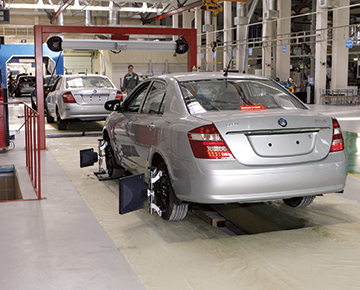
The President of Belarus believes that domestic experience and achievements should be added to BelGee passenger car production. Speaking at a session discussing the implementation of an investment project to launch assembly of passenger cars in Belarus, Mr. Lukashenko noted his long-held dream to initiate car manufacturing in Belarus.
He commented, “I have a dream: I’d like Belarus to manufacture passenger cars in addition to heavy-duty vehicles, trucks, medium-capacity trucks, and tractors. The cars should meet expected modern standards, to satisfy demand by corporations and individuals for Belarus-made cars.”
According to the President, contemporary conditions make such a launch near impossible alone, especially as there is so much global competition, for instance, from Mercedes, and from Japanese and Korean companies.
He is keen to find a partner ready to help Belarus on this path, combining domestic and foreign technologies. He underlines, “The car must offer advantages in quality and price.”
The People’s Republic of China seems a likely ally, being a world leader in this sphere. The project to assemble Geely cars in Belarus is a convincing argument, with some components being supplied domestically.
The President wishes to see a Belarusian car assembly project, aided by Chinese technologies but asserts that no ‘replicas’ are planned. Rather, he wishes the nation to bring its experience of assembling and making trucks and vehicle components to bear, making use of best practices. He believes that the National Academy of Sciences of Belarus could lead the way for the new BelGee cars.
The factory is currently being built, using a Chinese loan, and should have capacity to produce up to 60,000 cars annually, with output rising to 120,000 cars once a second stage facility opens.

Of course, finding markets is essential, but Mr. Lukashenko is convinced that Belarus will be able to assure domestic buyers of good quality as well as affordability, especially since the enterprise and after-sales service will be located in the country. “We cannot know whether Belarusians will buy our cars or will opt for more expensive, better known brands from abroad; this is the number one question,” emphasises the President.
Mr. Lukashenko is eager to analyse the financial and manufacturing aspects of the project and listened eagerly to a status report on the construction of the plant. Belarus’ Deputy Prime Minister, Vladimir Semashko, notes that equipment has been delivered, with installation to begin in January and February. The first phase of the plant should launch by the end of 2016, and, in 2017, it should produce 60,000 cars.
As far as market assessment is concerned, Mr. Semashko believes that, even under the most pessimistic scenario of market decline, the plant can sell 50,000 cars annually. “This is the amount that can and should be sold in 2017-2018,” he notes.
China’s CITIC is the general designer and general contractor of the project, under terms previously guaranteed to BelGee founders.
The Government of Belarus is convinced that value for money, safety, and service terms will help Geely automobiles find customers. In 2013, sales of Geely cars on the Russian market rocketed by 41 percent, while those of such leading automobile producers as Mercedes, Audi, Volkswagen, Renault, Citroen, Mitsubishi, and Honda dropped by 15-35 percent.
Today’s share of Chinese automobiles on the CIS market is just 4 percent but should soon reach 10 percent. According to Government assessments, within two years, demand on the Russian market alone should reach 3 million Geely cars.
“We could sell some 250,000-300,000 cars to this market. Our target is 120,000 vehicles per year, manufactured in line with the full production cycle, with the degree of localisation reaching at least 50 percent by July 2018,” adds the Deputy Prime Minister of Belarus. He points out that many Belarusian companies will be involved in producing components, to achieve this level of localisation.
According to the business plan, as much as $318 million will be invested in constructing the plant and internal infrastructure, while around Br320 billion will be dedicated to developing external infrastructure: roads, railroads, gas, electricity and water supply, and a sewerage system.
Once the first production line is commissioned, the plant will employ 1,285 workers, rising to 1,850-1,900 when the plant achieves full capacity. “These will be highly-qualified specialists who will work with state-of-the-art equipment and gain decent pay,” stresses Mr. Semashko.
The Head of State has asked that costs be minimised in setting up external infrastructure, underlining that the Belarusian Government should oversee the strategy and prospects of the enterprise’s development, while assessing demand and planning the manufacture of new models.
He also notes that the project will be under his personal control and has instructed the Presidential Administration and the State Control Committee to monitor the process of construction and to constantly keep him informed.
“We will have a good car,” the President is convinced.
By Vladimir Mikhailov












